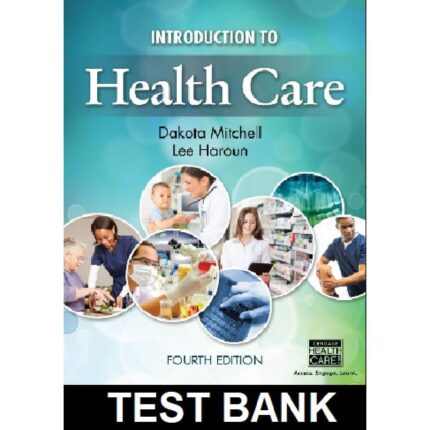Principles And Labs For Fitness And Wellness 13th Edition By Wener W.K. Hoeger – Test Bank
True / False
1. The most prevalent degenerative conditions in the United States arise from cardiovascular disease.
a. True
b. False
ANSWER: True
REFERENCES: Prevalence of Cardiovascular Disease
LEARNING OBJECTIVES: PLFW.HOEG.16.11.1 – Define cardiovascular disease and coronary heart disease.
OTHER: Bloom’s: Remember
2. Cardiorespiratory endurance is assessed most commonly by the minimal amount of oxygen (in milliliters) that every kilogram of body weight can utilize per minute of physical activity.
a. True
b. False
ANSWER: False
REFERENCES: Physical Inactivity
LEARNING OBJECTIVES: PLFW.HOEG.16.11.2 – Explain the importance of a healthy lifestyle in preventing cardiovascular disease.
OTHER: Bloom’s: Understand
3. Electrocardiograms are taken at rest, during the stress of exercise, and during recovery.
a. True
b. False
ANSWER: True
REFERENCES: Abnormal Electrocardiograms
LEARNING OBJECTIVES: PLFW.HOEG.16.11.4 – Assess your own risk for developing coronary heart disease.
OTHER: Bloom’s: Remember
4. HDLs tend to release cholesterol, which may penetrate the lining of arteries and speed up the process of atherosclerosis.
a. True
b. False
ANSWER: False
REFERENCES: Abnormal Cholesterol Profile
LEARNING OBJECTIVES: PLFW.HOEG.16.11.3 – Become familiar with the major risk factors that lead to the development of coronary heart disease, including physical inactivity, an abnormal cholesterol profile, hypertension, elevated homocysteine and C-reactive protein, diabetes, and smoking.
OTHER: Bloom’s: Understand
5. If a food label lists trans fat per serving as zero, you can eat as many servings as you like without worrying about absorbing any trans fat.
a. True
b. False
ANSWER: False
REFERENCES: Abnormal Cholesterol Profile
LEARNING OBJECTIVES: PLFW.HOEG.16.11.3 – Become familiar with the major risk factors that lead to the development of coronary heart disease, including physical inactivity, an abnormal cholesterol profile, hypertension, elevated homocysteine and C-reactive protein, diabetes, and smoking.
OTHER: Bloom’s: Understand
6. Margarines and salad dressings containing stanol esters increase cholesterol absorption in the intestine and should be avoided.
a. True
b. False
ANSWER: False
REFERENCES: Abnormal Cholesterol Profile
LEARNING OBJECTIVES: PLFW.HOEG.16.11.5 – Outline a comprehensive program for reducing the risk for coronary heart disease and managing the overall risk for cardiovascular disease.
OTHER: Bloom’s: Understand
7. High intake of honey and fruit juices can significantly raise bloodstream levels of triglycerides.
a. True
b. False
ANSWER: True
REFERENCES: Elevated Triglycerides
LEARNING OBJECTIVES: PLFW.HOEG.16.11.5 – Outline a comprehensive program for reducing the risk for coronary heart disease and managing the overall risk for cardiovascular disease.
OTHER: Bloom’s: Apply
8. Homocysteine is a blood-borne amino acid in the blood that is thought to dissolve plaque formation and help clear blocked arteries.
a. True
b. False
ANSWER: False
REFERENCES: Elevated Homocysteine
LEARNING OBJECTIVES: PLFW.HOEG.16.11.3 – Become familiar with the major risk factors that lead to the development of coronary heart disease, including physical inactivity, an abnormal cholesterol profile, hypertension, elevated homocysteine and C-reactive protein, diabetes, and smoking.
OTHER: Bloom’s: Remember
9. Two out of three diabetics will die from cardiovascular disease.
a. True
b. False
ANSWER: True
REFERENCES: Diabetes
LEARNING OBJECTIVES: PLFW.HOEG.16.11.3 – Become familiar with the major risk factors that lead to the development of coronary heart disease, including physical inactivity, an abnormal cholesterol profile, hypertension, elevated homocysteine and C-reactive protein, diabetes, and smoking.
OTHER: Bloom’s: Remember
10. Smoking is the single largest preventable cause of illness and premature death in the United States.
a. True
b. False
ANSWER: True
REFERENCES: Cigarette Smoking
LEARNING OBJECTIVES: PLFW.HOEG.16.11.3 – Become familiar with the major risk factors that lead to the development of coronary heart disease, including physical inactivity, an abnormal cholesterol profile, hypertension, elevated homocysteine and C-reactive protein, diabetes, and smoking.
OTHER: Bloom’s: Remember













Reviews
There are no reviews yet.